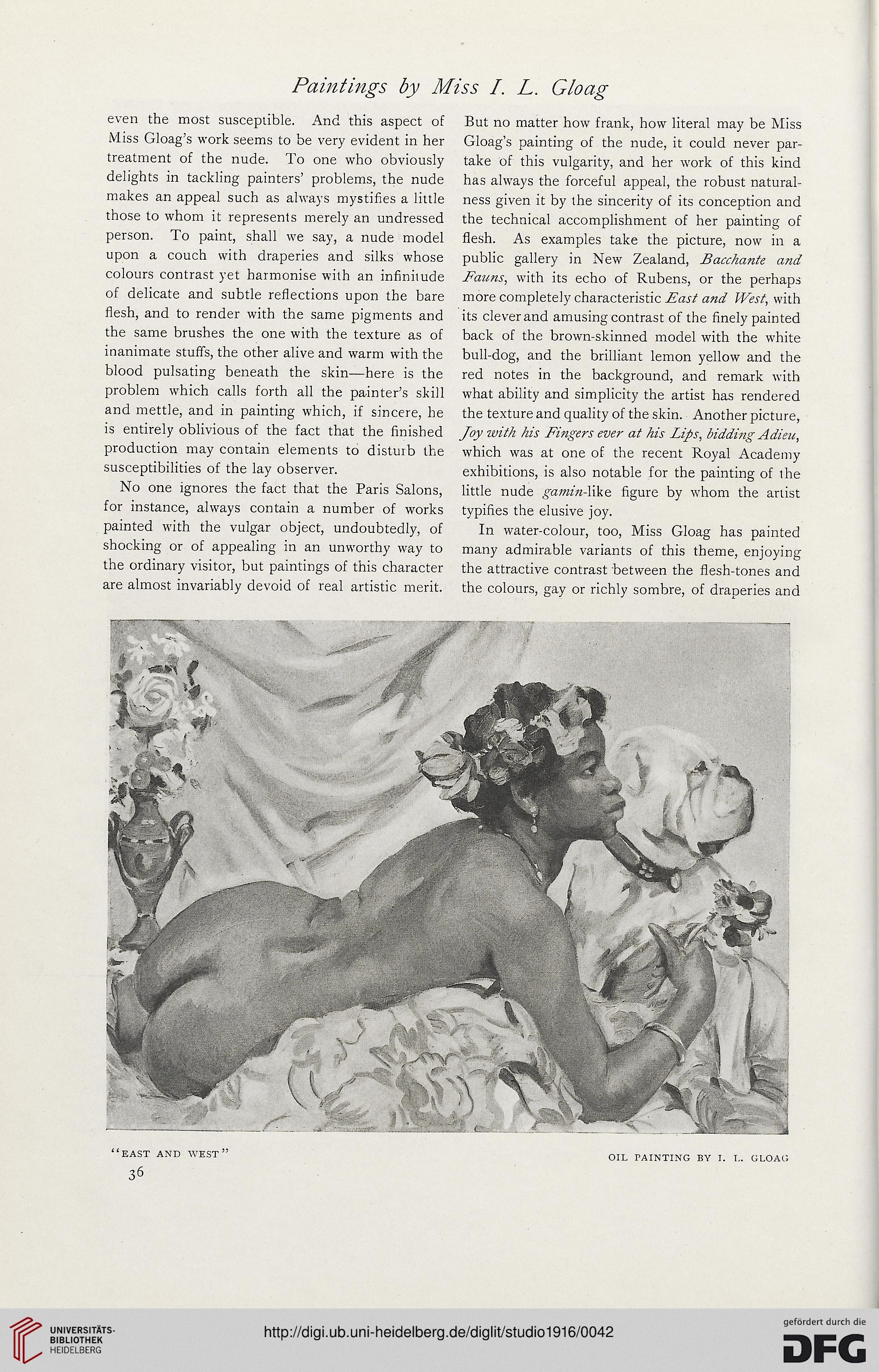Paintings by Miss I. L. Gloag
even the most susceptible. And this aspect of
Miss Gloag’s work seems to be very evident in her
treatment of the nude. To one who obviously
delights in tackling painters’ problems, the nude
makes an appeal such as always mystifies a little
those to whom it represents merely an undressed
person. To paint, shall we say, a nude model
upon a couch with draperies and silks whose
colours contrast yet harmonise with an infinitude
of delicate and subtle reflections upon the bare
flesh, and to render with the same pigments and
the same brushes the one with the texture as of
inanimate stuffs, the other alive and warm with the
blood pulsating beneath the skin—here is the
problem which calls forth all the painter’s skill
and mettle, and in painting which, if sincere, he
is entirely oblivious of the fact that the finished
production may contain elements to disturb the
susceptibilities of the lay observer.
No one ignores the fact that the Paris Salons,
for instance, always contain a number of works
painted with the vulgar object, undoubtedly, of
shocking or of appealing in an unworthy way to
the ordinary visitor, but paintings of this character
are almost invariably devoid of real artistic merit.
But no matter how frank, how literal may be Miss
Gloag’s painting of the nude, it could never par-
take of this vulgarity, and her work of this kind
has always the forceful appeal, the robust natural-
ness given it by the sincerity of its conception and
the technical accomplishment of her painting of
flesh. As examples take the picture, now in a
public gallery in New Zealand, Bacchante and
Fauns, with its echo of Rubens, or the perhaps
more completely characteristic Bast and West, with
its clever and amusing contrast of the finely painted
back of the brown-skinned model with the white
bull-dog, and the brilliant lemon yellow and the
red notes in the background, and remark with
what ability and simplicity the artist has rendered
the texture and quality of the skin. Another picture,
Joy with his Fingers ever at his Lips, bidding Adieu,
which was at one of the recent Royal Academy
exhibitions, is also notable for the painting of the
little nude gamin-Y\ke figure by whom the artist
typifies the elusive joy.
In water-colour, too, Miss Gloag has painted
many admirable variants of this theme, enjoying
the attractive contrast between the flesh-tones and
the colours, gay or richly sombre, of draperies and
OIL PAINTING BY I. I.. GLOAG
even the most susceptible. And this aspect of
Miss Gloag’s work seems to be very evident in her
treatment of the nude. To one who obviously
delights in tackling painters’ problems, the nude
makes an appeal such as always mystifies a little
those to whom it represents merely an undressed
person. To paint, shall we say, a nude model
upon a couch with draperies and silks whose
colours contrast yet harmonise with an infinitude
of delicate and subtle reflections upon the bare
flesh, and to render with the same pigments and
the same brushes the one with the texture as of
inanimate stuffs, the other alive and warm with the
blood pulsating beneath the skin—here is the
problem which calls forth all the painter’s skill
and mettle, and in painting which, if sincere, he
is entirely oblivious of the fact that the finished
production may contain elements to disturb the
susceptibilities of the lay observer.
No one ignores the fact that the Paris Salons,
for instance, always contain a number of works
painted with the vulgar object, undoubtedly, of
shocking or of appealing in an unworthy way to
the ordinary visitor, but paintings of this character
are almost invariably devoid of real artistic merit.
But no matter how frank, how literal may be Miss
Gloag’s painting of the nude, it could never par-
take of this vulgarity, and her work of this kind
has always the forceful appeal, the robust natural-
ness given it by the sincerity of its conception and
the technical accomplishment of her painting of
flesh. As examples take the picture, now in a
public gallery in New Zealand, Bacchante and
Fauns, with its echo of Rubens, or the perhaps
more completely characteristic Bast and West, with
its clever and amusing contrast of the finely painted
back of the brown-skinned model with the white
bull-dog, and the brilliant lemon yellow and the
red notes in the background, and remark with
what ability and simplicity the artist has rendered
the texture and quality of the skin. Another picture,
Joy with his Fingers ever at his Lips, bidding Adieu,
which was at one of the recent Royal Academy
exhibitions, is also notable for the painting of the
little nude gamin-Y\ke figure by whom the artist
typifies the elusive joy.
In water-colour, too, Miss Gloag has painted
many admirable variants of this theme, enjoying
the attractive contrast between the flesh-tones and
the colours, gay or richly sombre, of draperies and
OIL PAINTING BY I. I.. GLOAG




